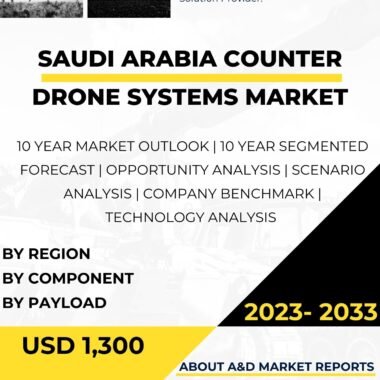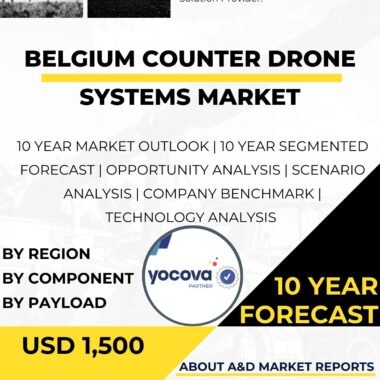Description
The counter-drone systems market in Spain is a critical component of the country’s defense industry, focused on countering the growing threats posed by unmanned aerial vehicles (UAVs) or drones. Drones, once primarily associated with civilian and commercial applications, have become increasingly prevalent in various military and security scenarios, leading to an urgent need for effective countermeasures to mitigate their potential risks. Spain recognizes the importance of countering drone threats to safeguard national security, protect critical infrastructure, and ensure public safety.
The adoption and development of counter-drone systems in Spain are driven by several factors, including the rapid proliferation of drones, the evolution of drone technology, the potential for drones to be used by malicious actors for nefarious purposes, and the need to protect sensitive installations and public events from potential drone attacks.
Drones have evolved to become smaller, more agile, and capable of carrying payloads, including explosives or surveillance equipment. As a result, they can be used by terrorist groups, criminal organizations, or hostile actors to conduct reconnaissance, disrupt critical operations, or carry out attacks.
The Spanish defense industry, in collaboration with research institutions and technology providers, is actively engaged in developing and deploying innovative counter-drone solutions. These systems encompass a range of capabilities, including detection, identification, tracking, and neutralization of rogue drones.
Detection is the first line of defense against unauthorized drones. Various sensor technologies, such as radar, electro-optical cameras, and radiofrequency scanners, are utilized to detect drones operating within restricted airspace or sensitive areas. Advanced drone detection systems can analyze drone flight patterns and distinguish between civilian and authorized drones and those with malicious intent.
Identification is crucial to differentiate between friendly drones, such as those operated by government agencies or commercial entities, and potential threats. Identification systems utilize various data sources, including drone registration databases and digital communication protocols, to verify the identity of drones within the airspace.
Once a rogue drone is detected and identified, tracking becomes paramount to maintain situational awareness and assess its trajectory and intent. Tracking systems employ sophisticated algorithms and data fusion techniques to monitor the drone’s movements and predict potential threat scenarios.
Neutralization or mitigation of drone threats is the final stage in the counter-drone process. Various methods can be used to neutralize unauthorized drones, including radiofrequency jamming, cyber interference, or the deployment of counter-UAV munitions. These measures are designed to disrupt the drone’s communication links and force it to land or return to its operator.
Spain’s counter-drone systems are designed to be scalable and adaptable to different operational environments, such as urban settings, rural areas, or maritime domains. Flexibility is essential, as the potential threats posed by drones can vary widely, ranging from simple civilian drones entering restricted airspace to sophisticated UAVs attempting to breach high-security installations.
The counter-drone systems market also addresses the need for integration with existing defense systems and airspace management networks. Seamless integration with air traffic control and military command and control systems allows for more effective coordination in response to drone threats.
The rapid advancement of drone technology presents an ongoing challenge for counter-drone systems. As drone capabilities continue to evolve, countermeasures must adapt to keep pace with new and emerging threats. Spain’s defense industry invests in research and development to stay at the forefront of counter-drone technology and maintain its ability to respond effectively to evolving drone threats.
Budgetary considerations are significant factors in the counter-drone systems market. Spain’s defense spending is subject to economic conditions and government priorities, which can impact the allocation of resources for research, development, and procurement of counter-drone technologies.
Spain’s commitment to international arms control agreements and export regulations also influences the use of counter-drone systems. Ensuring compliance with international standards is essential for facilitating defense exports and maintaining positive relationships with partner nations.
Additionally, Spain collaborates with other European countries and international organizations to address common counter-drone challenges collectively. Sharing best practices, conducting joint exercises, and coordinating response efforts enable Spain to leverage the expertise and capabilities of its partners, further enhancing its counter-drone readiness.
In conclusion, the counter-drone systems market in Spain is a critical component of the country’s defense industry. The proliferation of drones and the potential risks they pose to national security and public safety necessitate the development and deployment of effective countermeasures. Spain’s defense industry, in collaboration with research institutions and technology providers, is actively engaged in developing and deploying innovative counter-drone solutions. These systems encompass detection, identification, tracking, and neutralization capabilities to address a wide range of drone threats effectively. Flexibility, adaptability, and integration with existing defense systems are crucial aspects of Spain’s counter-drone strategy. As the drone landscape continues to evolve, Spain’s defense industry will remain focused on research and development to keep pace with emerging threats and ensure the country’s readiness to address drone-related challenges effectively.




